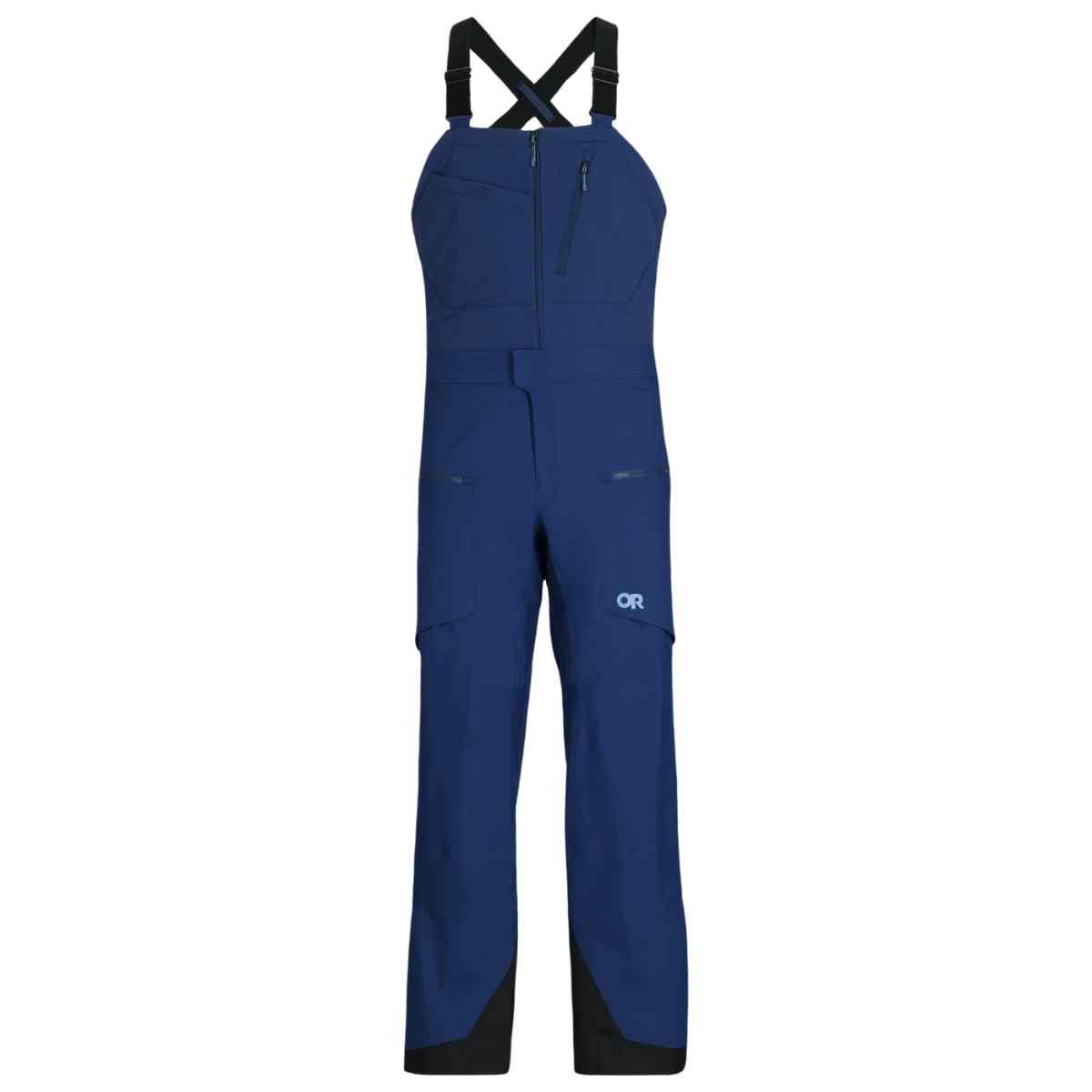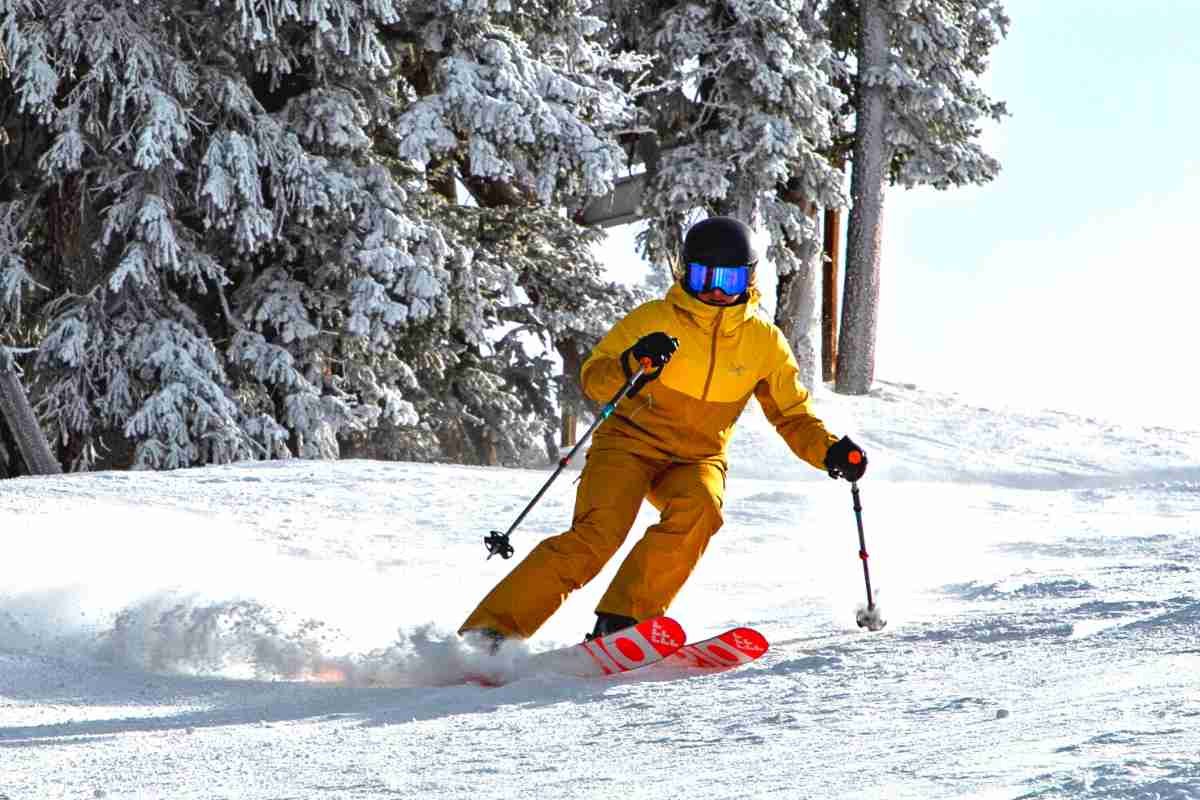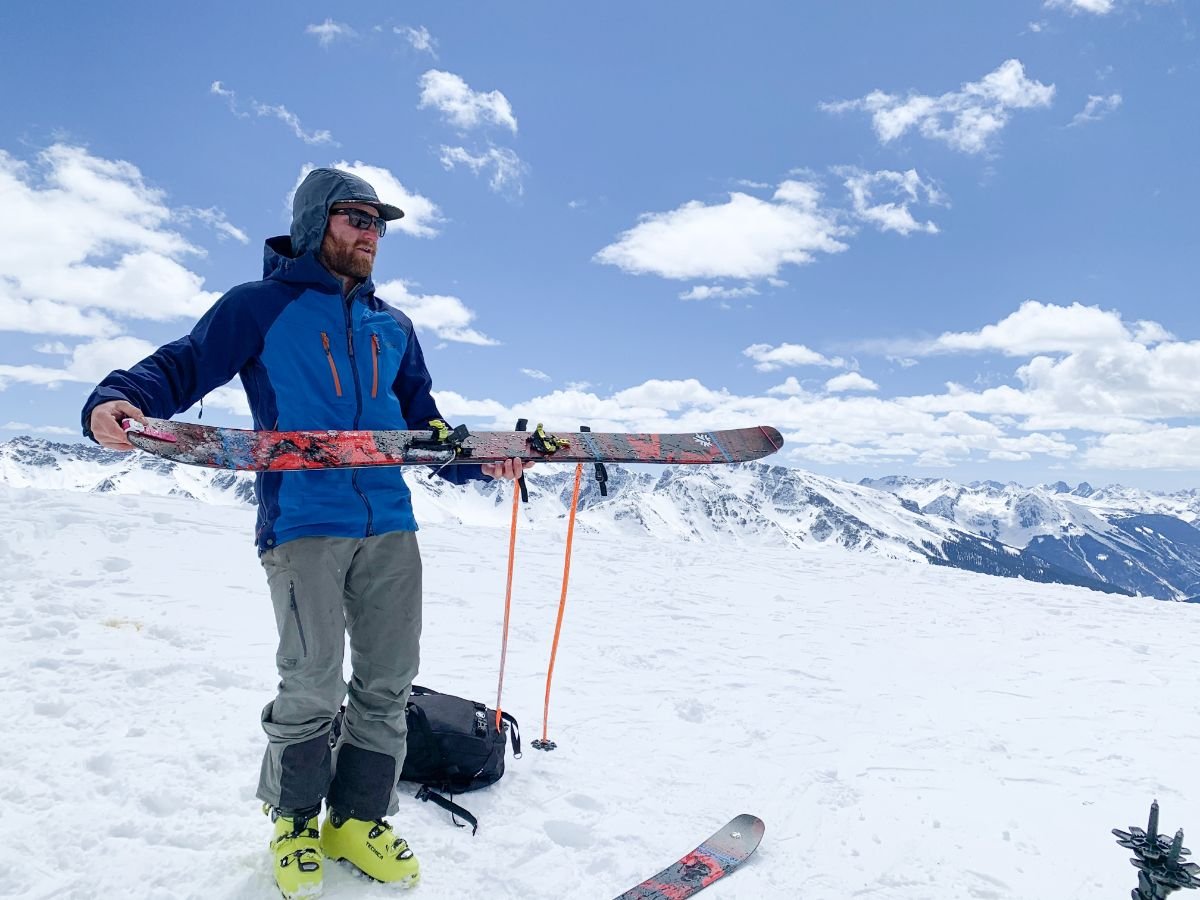Flylow Baker Bibs Ski Pants Review
Highly durable and waterproof, relaxed fit bibs
Home > Gear Reviews > Ski & Snow
January 13, 2025
Our verdict
After more than a year of testing and over 100 days between the resorts and in Colorado’s backcountry, the Flylow Baker bibs are still the favorite of our long-term tester, Quentin the French. A snowboarder, he’s one of three Treeline testers who had a chance to test out these highly durable and waterproof bibs. Overall, they offer a lot of style without being too loud; breathable, 3-layer waterproofing that’s thus far never wetted out, and a great value in the middle range of prices among the snow pants and bibs we tested.
We’re testing a size large and found that, as many other riders have said, the bibs are larger than most for the size. Otherwise, they are a reliable pair of bibs that should last for years, and they are more at home at the resort than in the backcountry. Read on to get the full beta on these bibs, which are one of our favorite pairs of men’s ski pants.
MEN’S
We write mission-driven gear reviews. To find the best gear, we combine expert reviews, everyday user opinions, and rigorous independent trail testing—never native ads or sponsored posts. We are 100% reader-supported and may make a small commission from some qualifying affiliate links. Learn more.
Specs
Weight: 950g
Material: 3-layer 100% polyester fabric
Type: hardshell
Number of pockets: 6
Available sizes: XS-XXL (tall version available)
Available colors: 7+
Price: $430
Comparison table
| MEN'S SKI BIBS | MSRP | PANT STYLE | SIZES | WATER- PROOFING | POCKETS | ADDITIONAL FEATURES |
|---|---|---|---|---|---|---|
| Flylow Baker Bibs | $430 | Hardshell bib | XS-XXL (tall version available) | Fully seam taped 3L + PFAS-free DWR | 2 zippered hand, zippered back, 2 zippered chest, 1 snap chest | Internal gaiters; inner and outer thigh vents; adjustable waist |
| Arc'teryx Sabre Bibs | $700 | Hardshell bib | S-XXL | 3L GORE-TEX ePE Gen 2 | 1 bib, 2 thigh | RECCO reflector; PowderCuffs |
| Outdoor Research Skytour AscentShell Bibs | $429 | Hardshell bib | S-XXL | Fully seam taped, 3-layer AscentShell | 1 chest beacon, 1 big, 2 cargo | Swing hatch, full center-front zipper, zippered outer thigh vents, internal gaiters |
| The North Face Freedom Bibs | $220 | Hardshell bib | XXS-XXL (lengths available) | Seam sealed 2L DryVent + PFAS-free DWR | 2 zippered hand, 1 Velcro cargo, 2 Velcro chest (bibs) | Seam-sealed; adjustable waist; Chimney Venting system; inner thigh vents |
| Patagonia Powder Town Bibs | $299 | Hardshell bib | S-XXL | H2No 2L | 1 chest, 2 cargo | RECCO reflector; outer leg vents; gaiters; back webbing loop |
| Outdoor Research Hemispheres II Bibs | $648 | Hardshell bib | S-XXL | fully taped GORE-TEX with 3-layer fabric | 3 zippered pockets | Internal gaiters, adjustable suspenders, Articulated knees, KEVLAR kick guards |
Who is it for
Quentin having fun in the Flylow Baker in the backcountry near Berthoud Pass. Photo by Chris Meehan.
Though designed with freeskiers in mind with a generous, relaxed fit, these were also favored by Quentin and our other snowboarding testers as a snowboard bib. As he remarks, “these bibs would definitely be my top recommendation for comfort, functionality, and durability.” Chalk that up to the relaxed fit as well as to the nearly bombproof reinforced fabric at the knees and ankles.
Resort and backcountry skiers
Flylow’s Baker Bibs are more of a resort bib than a backcountry bib. With thicker fabric than many backcountry bibs and bigger suspender buckles that can make wearing a backpack on a long day in the backcountry less comfortable, the Baker bibs are noticeably heavier (weighing about 2 pounds!) than other backcountry options.
They also lack a dedicated beacon pocket, but any enterprising wearer can attach the beacon to other points on the bibs if they want to do so. However, with generous inner and outer thigh vents, they will perform well in the backcountry if needed. We just wouldn’t recommend them as a primary backcountry bib.
Skiers seeking all-day protection:
The Baker bibs don’t have any insulation, which we think is fine as we prefer customizing a layered approach to keeping comfy while on the snow. However, the thicker fabric does retain heat a little better than thinner options. We’d recommend wearing them with a base layer bottom on all but the warmest days in the resort.
In terms of breathability and waterproofing, the bibs do breathe alright, but their primary means of dumping heat are the thigh zippers. When those vents are closed these bibs have some of the best waterproofing we’ve seen. This combo of being able to dump massive amounts of heat when needed, the extra warmth of the thicker fabric, and the bomber waterproofing make them ideal for all-day riding at the resort when conditions may vary throughout the day.
Freeriders and all-mountain skiers:
These bibs are definitely versatile for the resort. With their style and burly features, they tilt more towards the freeskier and snowboarder. But, with their venting capabilities and reinforcements, they can also work the rider who wants to take on the whole mountain, glades, ice sheets, and all.
How we tested
Quentin enjoying a lift ride at Eldora in the Baker bib. Courtesy Quentin Perrot.
We’ve had these bibs for over a year now and have over 100 days wearing them in Colorado. We’ve used them from mid-to-late November when the snow starts accumulating in the Rockies, through wind-whipped snow squalls, and into the sunny May corn snow, where venting and breathability are the most paramount features when uphilling.
We’ve tested them in the backcountry in places like Berthoud, Jones, and Loveland passes in Colorado, skinning multiple miles and dropping in at as high as 13,000 feet into miles-long runs. We’ve also romped through the trees, blacks, and parks in them at ski resorts, like Loveland, Eldora, and Arapahoe Basin, giving them a wide range of use.
What we liked
Style
Waterproofness
Vents
Color choices
Size choices
Variety of pockets
Bombproof fabric
What could be better
Testers say size ran too big
Heavier than other options (2 pounds)
Suspender buckles can dig into shoulders
No true beacon pocket
Features
Quentin showing off the thigh pocket size of the Flylow Baker bib. Courtesy Quentin Perrot
With the Baker, Flylow hits almost all the sweet spots, using quality materials and features, without relying on all the best-known name-brand fabrics and treatments.
Materials
The Baker bibs primarily use Intuitive’s 3-layer hardshell fabric with a stretchy nylon mesh on the upper part of the back and Cordura-reinforced ankles and knees. The DWR treatment on the fabric is PFC free and has thus far outlasted our testers’ best efforts to get wet in them. When compared to some of our other favorite bibs, the heavier materials lack the stretch and flexibility of our favorite backcountry bib choices. However, these are ideal at a resort and in the snow park, thanks to the bomber materials and DWR.
Ventilation
“It breathes well, and you can easily adjust airflow with the large zippers on the legs,” Quentin says. The bibs feature zippered mesh-less vents both on the inside and outside of the thighs, making them great for dumping heat while climbing uphill in the backcountry or on warm days at the resort. While heavier than other options, the back panel is a stretch mesh, which also allows the bibs to breathe there as well.
Pockets
Of all the snow bibs and pants we tested the Baker bibs had by far the most pockets with a total of seven—including a butt pocket and a thigh pocket on the right side, making the bibs ideal for anyone trying to smuggle some extra beers on their person at the resort. Or, more practically, to carry a tool, camera, phone, snack, a small plush doll, a cardboard “hi mom!” sign, travel Scrabble, etc. Did we mention these are the Carhartts of ski bibs?
Flylow also manages to stack three pockets on the front of the bib, including a mesh pocket that looks like a beacon pocket. However, it lacks something to connect the beacon leash to…something that doesn’t phase Quentin on backcountry days: “I don't use the beacon pocket as I like the harness better in general, I use it to put my joints though, and it works well for that….!”
We found the exterior pockets are well placed and easy to use, even with gloves on, but you’ll need to take gloves off to access the bib pockets. We haven’t noticed any issues with water getting through the zippers.
Durability
The reinforced fabric at the knees and ankles are great for snowboarders and freeskiers alike, as the ankle and the knees are the most likely parts of bibs or snow pants to get shredded on trees, rocks, rails, terrain park features, and the steel edges of skis and snowboards.
Or as Quentin says of the reinforced knees: “Best feature. The fabric is once again quite impressive and also provides a bit of cushion and insulation, which I personally really appreciate since I often rest on my knees being a snowboarder.”
Waterproofing
The bibs sport Intuitive’s PFAs-free, 3-layer waterproofing, which somehow Quentin hasn’t managed to get wet in yet. “Waterproofing is so far very impressive, I've never had any problem with water and as I you know I do fall a lot. No leak or weak point on the bibs, everything works great and it keeps you dry,” he observes.
Fit
We’re testing a size large in the red Bigfoot color. “I do like the fit a lot, although as you know they are pretty big for me,” Quentin says. He’s about 6 feet tall and weighs about 155 pounds, says. “It's a little larger than other bibs (even in the right size), and that makes it look good in my opinion. The color is great.” The bibs also loosely fit the 5’10”, 195-pound author and another tester of similar size.
The Baker bibs offer the largest, roomiest fit of all the bibs we tested. It allows for decent freedom of movement, especially for snowboarders and the way they move. They’re more adept going downhill than uphill, however.
In terms of size and color, the Baker bibs are offered in one of the widest ranges of both. They’re offered in 7 natural-looking colors (nothing too bright and flashy) and six sizes from XS to XXL. In addition, they’re also offered in short and tall lengths, giving them one of the best size ranges we’ve seen. Still, the Baker bibs are only offered in a men’s fit. If you’re looking for the equivalent in a woman’s fit, check out the Flylow Foxy bibs. They’re our favorite full bibs in our Best Women's Ski Pants of 2024/25.
Performance in the field
Quentin’s ‘joint pocket’ on the Flylow Baker bib. Courtesy Quentin Perrot.
The Flylow Baker Bibs largely live up to their claim of being "ideal for high-intensity skiing, providing ample ventilation and rugged waterproofing to handle a wide range of winter activities.” However, we still think they’re best for in-bounds riders who will mostly freeski or snowboard.
Sustainability and brand ethics
From a PFC-free, bio-based, durable water repellent (DWR) to bluesign and Oeko-Tek approved materials, Flylow has put sustainability at top of mind in the Baker Bibs. That’s not even considering how burly these bibs are, which should make sure they last for many years—maybe you’ll hand them down to your teen or a nephew.
Or maybe you’ll take advantage of Flylow’s other efforts to reduce waste, like Flylow Leftover Land, its partnership with Geartrade—the used gear trade market—which rewards Flylow gear users with a credit toward new gear for sending old Flylow gear back.
No matter what, the company is doing more than many other companies to reduce its impact on the globe. That also includes using post-consumer materials in roughly 80% of its gear and sourcing down with Allied Feather and Down’s “Track My Down” system that meets the Responsible Down Standard and makes sure its down supply chain is transparent.
Should I buy the Flylow Baker Bib?
Quentin doing a mic check at Loveland Ski Area in the Flylow Baker Bib. Photo by Chris Meehan.
Bryan showing off the Flylow Baker bib after a day at Wolf Creek Ski Area.
In the end, we’d recommend these stalwart bibs, available in a wide range of sizes and colors with a ton of well-placed pockets, for skiers and snowboarders who aren’t afraid to take a fall or five in the terrain park or on tough slopes. Even without insulation, they stay pretty toasty and have some of the best venting options for dumping heat. As such, we think they’re best for resort-first riders who ski or ride often, and also enjoy going in the backcountry sometimes and need a versatile pair of bibs.
For more on ski apparel, check out our What to Wear Skiing guide.
Where to buy Flylow Baker
The Flylow Baker are popular, so you have options when it comes to retailers. Here are some of the pros of the retailers.
Backcountry
Pros: Frequent sales for Expedition Perks members (free to join), fast shipping, Gearhead chat customer service is excellent
EVO
Advice on where to buy
In general for pants, we recommend purchasing from a place with easy or free returns like REI or Zappos. Trying on pants is an important way to get the sizing right. With both those retailers, if your funds allow, you can buy two sizes and easily return one. Additionally, check reviews to see whether other users recommend sizing up or down.
Similar products
Outdoor Research Hemispheres II Bib
Weight: 24 oz/ 681g
Material: 3-layer GORE-TEX fabric
Available sizes: S-XXL
Available colors: 4 colors
Price: $648
As a skier who’s in the backcountry as much as at the resort, the Outdoor Research Hemispheres II Bib is currently my favorite bib—even though the Skytour was our overall favorite pick for most people in our Best Men’s Ski Pants guide. It’s lightweight, breathes well, and stretches well—three things the Baker doesn’t do as well. This makes the Hemispheres II a more versatile and backcountry-friendly bib than the Baker and better suited for the rider who isn’t afraid of spending a little more for a premium bib who wants to spend more time in the backcountry than on the lifts.
Outdoor Research Skytour AscentShell Bib
Weight: 733g
Material: 3-layer AscentShell Air fabric with PFAS-free DWR
Available sizes: S-XXL
Available colors: blue, black
Price: $429
The Skytour bib from Outdoor Research is our favorite overall bib pick. It’s offered at a good price point and has all the features one would want in a backcountry bib. It’s lightweight, has good ventilation on the thighs, and a dedicated beacon pocket. It transitions over to resort duty better than the Baker bib can transition to backcountry duty. Someone looking for a great value backcountry bib should consider the Skytour over the Baker.
Arc'teryx Sabre Bib
Weight: 1 lb 9.6 oz.
Material: 3-layer fabric GORE-TEX ePE
Available sizes: S-XXL
Available colors: 2
Price: $700
None of our testers were too fond of the fit of the Arc'teryx Sabre Bib. For instance, Quentin, who is more lithe than the author, still found it a little too skinny and restrictive. The fabric of the Sabre felt pretty bombproof, but we also didn’t notice as much stretch from the Sabre as we’d like. For someone tall and skinny who wants a pretty tight fit, the Sabre might be a good buy, but we think there are other options out there, and the Baker is a much better one.
About the author / Why you should trust us
Chris skiing in the backcountry near Crested Butte.
As an outdoors writer covering adventure and gear, I write regularly about the outdoors and enjoy outdoor activities all year round, including skiing on the slopes and backcountry, snowshoeing, and ice climbing. I’ve authored numerous gear guides for Treeline Review, write for Popular Mechanics, Bicycling Magazine, Popular Science, Backpacker, and other outdoor publications/organizations.
These days, I spend most of my time skiing, ice climbing, mountain biking, backpacking, hiking, climbing, and crisscrossing Colorado and the Rocky Mountain region. I enjoy using all my knowledge of gear and skills to learn about new equipment and how it will benefit me—yes, I’m selfish—as well as Treeline’s readers.
I have authored multiple outdoor guidebooks, including covering mountain bike adventures. My most recent Falcon Guide is "Colorado’s Best Front Range Adventures: The Greatest Hiking, Climbing, Paddling and More From Denver to Colorado Springs and Fort Collins.” In it, I cover the region's best hiking, cycling, climbing, and rafting.
I’m also the author of Falcon Guide’s “Climbing Colorado's Fourteeners: From the Easiest Hikes to the Most Challenging Climbs” and edited Justin Lichter’s excellent guide to thru-hiking titled “Trail Tested: A Thru-Hiker's Guide To Ultralight Hiking And Backpacking.” This experience has helped me become a first-rate gearhead and product tester.
I have 20-plus years of exploring, skiing, climbing, mountain biking, hiking, backpacking, guiding, and playing in the wild. I worked with National Geographic and their mapping division in developing their Colorado 14ers Map Pack Bundle. I’ve written about hiking and climbing for Elevation Outdoors, including stories about Colorado 14ers and outdoor apps to boost adventures.















